20 Species of Hummingbirds (With Pictures)
Last Updated on
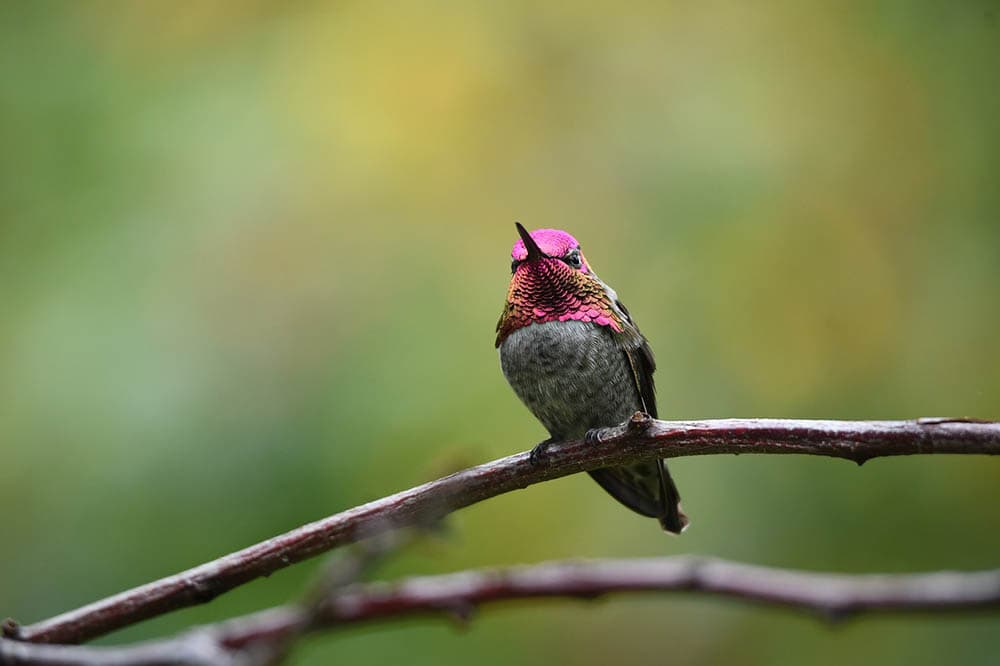
With over 330 types of hummingbirds, there’s no way we can list them all here. Instead, we’ve highlighted the most common, the most impressive, and the rarest hummingbirds out there!
This way, you’ll have a better understanding of the species as a whole, and the next time you spot a hummingbird, you’ll have a better idea of what you’re looking at.

The 20 Most Common Species of Hummingbird
1. Ruby-Throated Hummingbird

| Scientific Name | Archilochus colubris |
| Estimated Current Population | Over 7 million |
| Habitat | Woodland areas and gardens |
| Range | Eastern United States and Mexico |
The ruby-throated hummingbird is the most common type of hummingbird in the world and one of the few species that you’ll find in the eastern United States. Their name comes from the signature red band around their throat, but they also have a green exterior coat and white underside.
If you live in the eastern United States and see a hummingbird flying around, there’s a good chance that it’s a ruby-throated hummingbird!
2. Anna’s Hummingbird
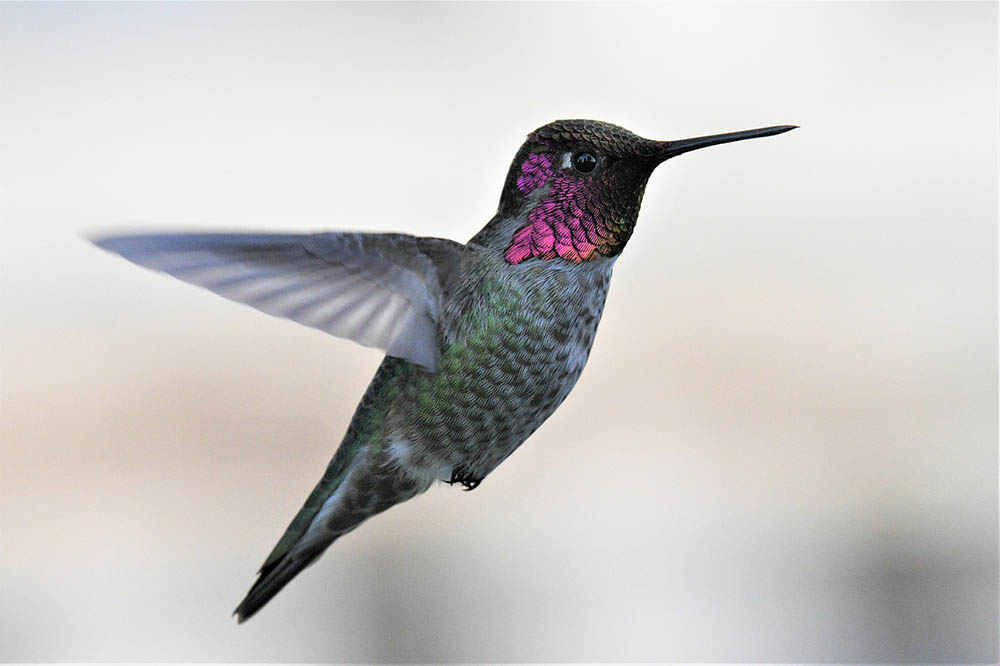
| Scientific Name | Calypte anna |
| Estimated Current Population | 1.5 million |
| Habitat | Gardens, scrub, and woods |
| Range | Western United States and Mexico |
Anna’s hummingbirds are a common hummingbird species, although you’ll have to go to the Pacific coast to see one. Males have reddish-pink feathers around their heads, while females maintain the same coloring of green and gray all along their bodies.
This makes it easy to tell them apart. You’ll also never see any orange markings on Anna’s hummingbird, making them relatively easy to distinguish from other hummingbird species.
3. Rufous Hummingbird
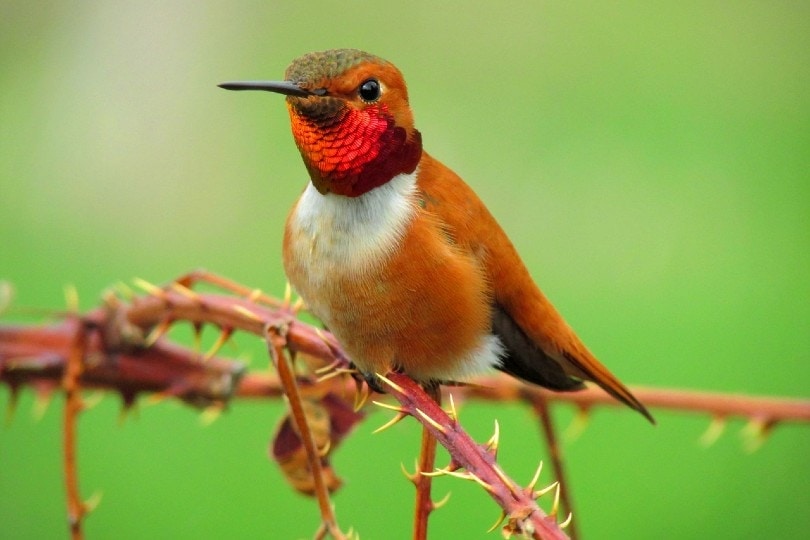
| Scientific Name | Selasphorus rufus |
| Estimated Current Population | 11 million |
| Habitat | Open yards, parks, and forest tree lines |
| Range | Western United States, Canada, Mexico, and Central America |
With a population of about 11 million, Rufous hummingbirds are far from rare. Still, they have one of the most extensive ranges of all hummingbirds, with their range starting deep in western Mexico and Central America and going as far north as Alaska!
It’s the only hummingbird species that you’ll find traveling that far north, and they often have bright orange markings that can help you identify them.
4. Black-Chinned Hummingbird
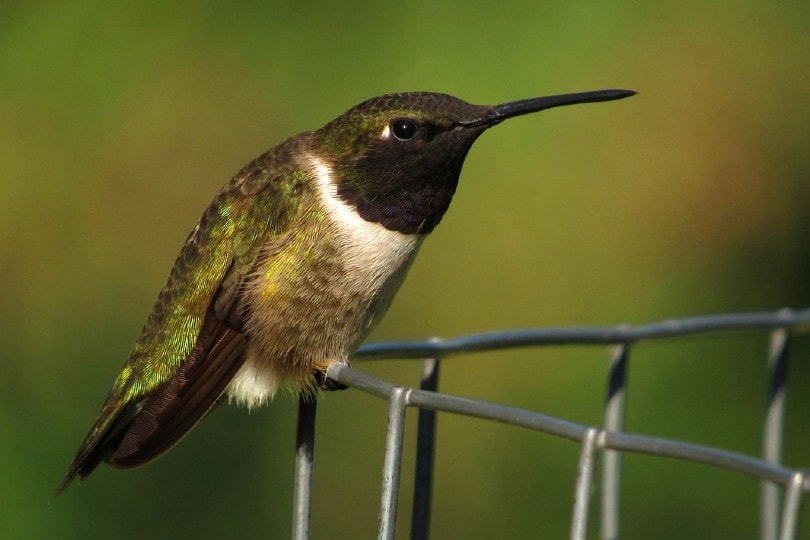
| Scientific Name | Archilochus alexandri |
| Estimated Current Population | 5 million |
| Habitat | Lowland deserts, mountain forests, and certain urban areas |
| Range | Western United States and Mexico |
If you live in the western United States, there are plenty of different hummingbird species around, and a common one is the black-chinned hummingbird. They’re one of the few hummingbirds that will occasionally venture into urban settings, so for many city-dwellers, it’s the only hummingbird that they’ve ever seen.
There are about 5 million of these birds out there, though, and you can often find them in lowland deserts and mountain forests.
5. Calliope Hummingbird
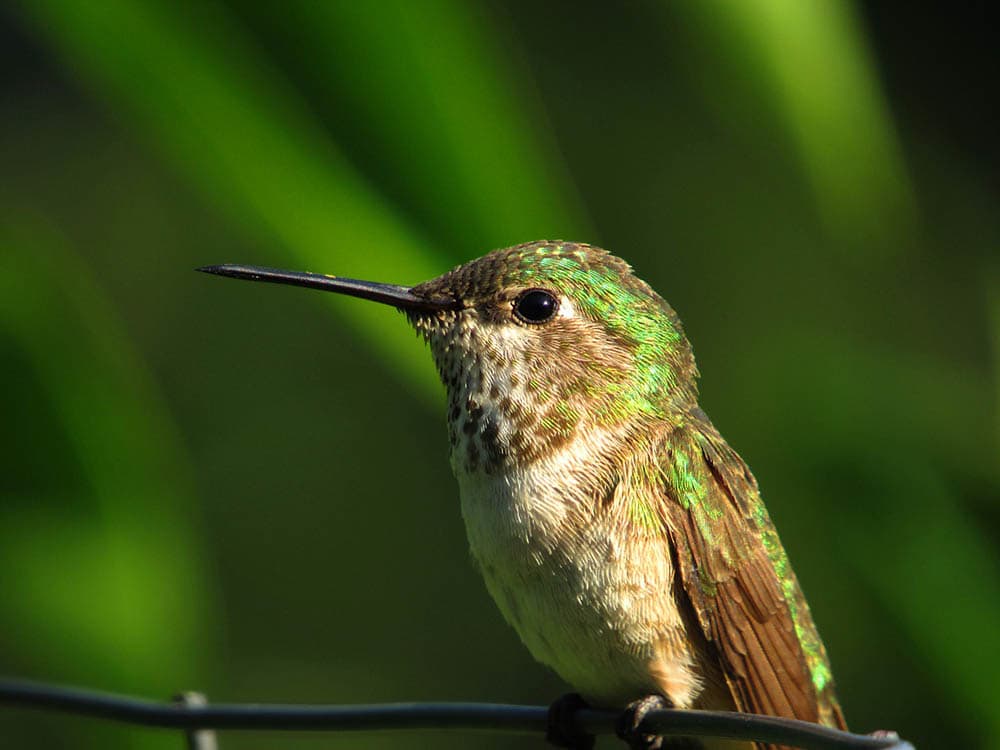
| Scientific Name | Selasphorus calliope |
| Estimated Current Population | 1 million |
| Habitat | Mountain meadows, aspen thickets, open forests, and streams |
| Range | Western United States, Canada, and Mexico |
While the calliope hummingbird doesn’t have quite the same extensive range as the rufous hummingbird, they still go far north. They travel well into Canada at times, although you can find them in more southern climates for most of the year.
The calliope hummingbird has distinctive purple stripes along their chin and breast, making them one of the more unique-looking hummingbirds.
6. Costa’s Hummingbird

| Scientific Name | Calypte costae |
| Estimated Current Population | 3.6 million |
| Habitat | Lower western United States and Mexico |
| Range | Desert, coastline, and forest |
Costa’s hummingbirds live primarily in Mexico, although you can find them in certain southwestern portions of the United States. Female costa hummingbirds have more pronounced colorings, with bright purple feathers around their eyes and chest.
Males don’t have this bright coloring, but they’ll have the signature dull green and gray hue throughout their bodies.
7. Broad-Tailed Hummingbird
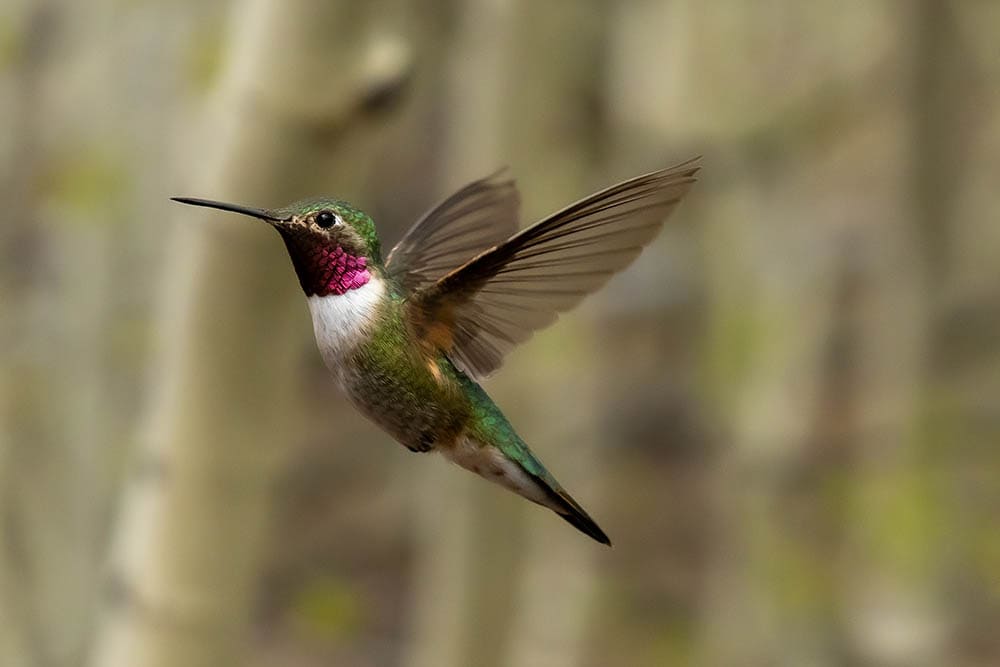
| Scientific Name | Selasphorus platycercus |
| Estimated Current Population | 3.8 million |
| Habitat | High-elevation meadows, forests, and forest openings |
| Range | Mountain-west United States, Mexico, and Central America |
While most hummingbirds stick close to the coastline, that’s not the case with the broad-tailed hummingbird. They prefer higher elevations, which is why you can often find them throughout the mountainous regions in the western United States.
They’re a relatively common hummingbird in these areas. Males have a rose-colored patch below their beaks, while the rest of the bird is green and white on both males and females.
8. Allen’s Hummingbird
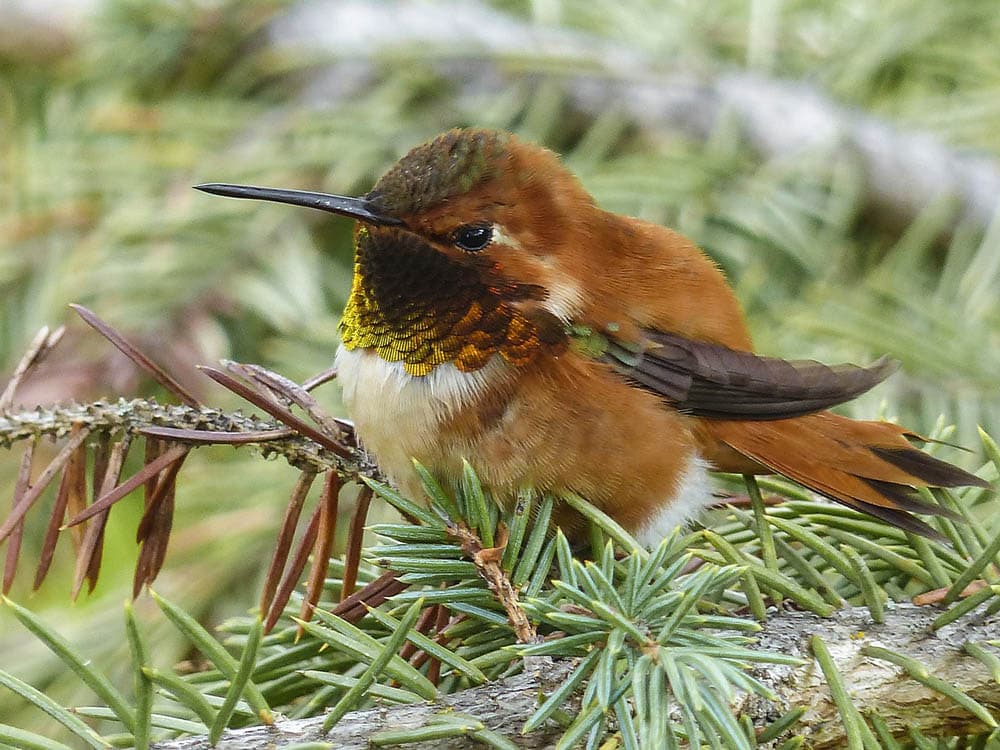
| Scientific Name | Selasphorus sasin |
| Estimated Current Population | 1.7 million |
| Habitat | Coastal forest |
| Range | Southwestern United States and Mexico |
One of the more striking hummingbirds that you’ll find is Allen’s Hummingbird. They have a copper-orange coloring around their head, while the rest of their body contrasts with a green hue.
They live primarily along the coastline on the western side of the United States and Mexico, and their numbers near 2 million.
9. Berylline Hummingbird

| Scientific Name | Amazilia beryllina |
| Estimated Current Population | 5 million |
| Habitat | Mountain forests and canyons |
| Range | Western Mexico and northern Central America |
While the Berylline hummingbird is one of the most common hummingbirds out there, you won’t find any in the United States. The northern-most part of their range stops just south of the United States and Mexico border, and they’re more prevalent even farther south.
They love mountain forests and canyons, and they have bright green coloring around their head that makes them a joy to look at.
10. Green-Breasted Mango Hummingbird

| Scientific Name | Anthracothorax prevostii |
| Estimated Current Population | Unknown (between 500,000 and 5 million) |
| Habitat | Forest edges and clearings in tropical lowlands |
| Range | Northeastern Mexico and Central America |
While you can technically spot a green-breasted mango hummingbird in southern Texas, it’s a rare occurrence, and you’re far more likely to spot them south of the border. Their current population is unknown, but there might be as many as 5 million out there.
They have a green hue throughout, but if you see one in flight, you can catch sight of the bright coloring under their tail feathers.
11. Broad-Billed Hummingbird

| Scientific Name | Cynanthus latirostris |
| Estimated Current Population | 2.2 million |
| Habitat | Mountainous canyons |
| Range | Western and southern Mexico |
The broad-billed hummingbird is an example of a hummingbird that you might occasionally spot in the United States, but they’re far more prevalent in Mexico.
There are over 2 million of these birds, and they love living in the mountains. The colors of these birds vary quite a bit, but blue and green colorings are common.
12. Buff-Bellied Hummingbird

| Scientific Name | Amazilia yucatanensis |
| Estimated Current Population | 5 million |
| Habitat | Open woodland and gardens |
| Range | Gulf of Mexico coastline, Florida to Mexico |
Compared to other hummingbirds, the buff-bellied hummingbird can be found in a completely different part of the world. They live along the Gulf of Mexico, all the way from Florida down to the southernmost provinces in Mexico.
They live along the coastline, but they’ll often frequent gardens and open woodland, making it a bit easier to spot them. They have incredibly long beaks and are usually green and pink in color.
13. Rivoli’s Hummingbird

| Scientific Name | Eugenes fulgens |
| Estimated Current Population | Unknown (between 500,000 and 5 million) |
| Habitat | Pine-oak forests |
| Range | Southern mountain-west United States, Mexico, and Central America |
Rivoli’s hummingbirds have a unique appearance, with purple head feathers and a bright blue-green appearance below their beak. They primarily live in elevated regions in the forest, and you can find them from Central America all the way to the southern mountain-west regions in the United States.
14. Blue-Throated Mountain-Gem
https://www.instagram.com/p/COF1VLmAnhp/
| Scientific Name | Lampornis clemenciae |
| Estimated Current Population | 2 million |
| Habitat | Wooded streams in canyons |
| Range | Central Mexico and Central America |
Most of the blue-throated mountain-gem hummingbird is a dull grey with occasional flecks of green. But while females consist of entirely these colors, males sport a bright blue gorget below their beak.
This gorget will glimmer in the right sunlight, making them a gorgeous bird to look at. They have long beaks and primarily live near wooded streams in canyons. It’s a specific niche, but with a over 2 million bird population, they seem to be doing just fine.
15. Lucifer Hummingbird

| Scientific Name | Calothorax lucifer |
| Estimated Current Population | Unknown (between 50,000 and 500,000) |
| Habitat | Arid slopes and desert canyons |
| Range | Deep south United States, northern and central Mexico |
It might be an ominous-sounding name, but if you’re lucky enough to spot a Lucifer hummingbird, you won’t be disappointed. They live along a thin strip in Central America and Mexico, but occasionally, they’ll venture into the United States.
They live in desert regions, and males sport an extremely bright purple gorget. Females lack this coloring and have a cream-colored appearance instead. The rest of the bird is gray-green on both males and females.
16. Mexican Violetear
https://www.instagram.com/p/CPDuPBIAzcQ/
| Scientific Name | Colibri thalassinus |
| Estimated Current Population | Unknown |
| Habitat | Forest clearings and edges |
| Range | Central Mexico and Central America |
While the exact population numbers of the Mexican Violetear are unknown, we do know that you’ll need to travel to central Mexico or Central America to spot one.
They have a bright green coloring and blue patches throughout their bodies.
17. Plain-Capped Starthroat
https://www.instagram.com/p/CdWdskbOh-p/
| Scientific Name | Heliomaster constantii |
| Estimated Current Population | Unknown |
| Habitat | Dry forest and lowland areas near streams |
| Range | Western Mexico and Central America |
We don’t know how many plain-capped starthroat hummingbirds there are, but you’ll need to head into Mexico or Central America to spot one.
Compared to most other hummingbirds, the plain-capped starthroat doesn’t have a signature appearance that pops. They have long beaks and a green-gray coloring, but they don’t have the same bright hues that you’ll find in other hummingbird species.
18. Bahama Woodstar
https://www.instagram.com/p/CRKF3dagvwK/
| Scientific Name | Calliphlox evelynae |
| Estimated Current Population | Unknown |
| Habitat | Gardens, scrubland, lowland, and forest edges |
| Range | Bahama Archipelago islands and Florida |
If you’re in southern Florida or the Bahama Archipelago islands and spot a hummingbird, there’s a good chance that they’re the Bahama Woodstar. They love hanging out in gardens, scrubland, and along forest edges, so they’re among the easier hummingbirds to spot.
Males have a bright purple coloring below their beak, while females have a plainer appearance that matches the rest of their bodies.
19. Bumblebee Hummingbird
https://www.instagram.com/p/CZ66iTTlMpd/
| Scientific Name | Atthis heloisa |
| Estimated Current Population | 250 to 1,000 |
| Habitat | Humid mountain forests |
| Range | Mexico and Arizona |
The smallest bird in North America is the bumblebee hummingbird, but with a population between 250 and 1,000, they might not hold that title for much longer. They only stand between 2.8 and 3 inches in height, making them truly tiny.
The trouble is finding one. There are not many left, and you’ll need to travel to either Mexico or Arizona. If you’re lucky enough to spot one of these beautiful birds in the wild, you’ll notice a bright purple plumage below the beak of males.
- Related Read: 10 Types of Hummingbirds in Arkansas
20. Cinnamon Hummingbird
https://www.instagram.com/p/Cba1cS2O3VU/
| Scientific Name | Amazilia rutila |
| Estimated Current Population | 500,000 |
| Habitat | Forests |
| Range | Western Mexico and Costa Rica |
The cinnamon hummingbird is not nearly as endangered as some other birds on this list. They live exclusively on the coastline of Mexico. They’re primarily on the western side of the country, but down toward Central America, they inhabit both coasts.
They have bronze plumage that is more striking than it sounds, making them a rare joy to spot.
Related Read: 10 Best Hummingbird Feeders: Reviews & Top Picks

In Conclusion
Hummingbirds are among nature’s most precious creations. These tiny birds flutter at incredible speeds and have migration ranges that are simply astounding considering their size. There are hundreds of species out there, and you can go your whole life without seeing them all!
Hopefully, now you have a better understanding of these birds, and who knows, maybe the next time that you spot a hummingbird, you’ll know exactly what you’re looking at!
See also: 6 Types of Hummingbirds in Michigan (With Pictures)
Featured Image Credit: Veronika_Andrews, Pixabay
Table of Contents
- The 20 Most Common Species of Hummingbird
- 1. Ruby-Throated Hummingbird
- 2. Anna’s Hummingbird
- 3. Rufous Hummingbird
- 4. Black-Chinned Hummingbird
- 5. Calliope Hummingbird
- 6. Costa’s Hummingbird
- 7. Broad-Tailed Hummingbird
- 8. Allen’s Hummingbird
- 9. Berylline Hummingbird
- 10. Green-Breasted Mango Hummingbird
- 11. Broad-Billed Hummingbird
- 12. Buff-Bellied Hummingbird
- 13. Rivoli’s Hummingbird
- 14. Blue-Throated Mountain-Gem
- 15. Lucifer Hummingbird
- 16. Mexican Violetear
- 17. Plain-Capped Starthroat
- 18. Bahama Woodstar
- 19. Bumblebee Hummingbird
- 20. Cinnamon Hummingbird
- In Conclusion
About the Author Robert Sparks
Robert’s obsession with all things optical started early in life, when his optician father would bring home prototypes for Robert to play with. Nowadays, Robert is dedicated to helping others find the right optics for their needs. His hobbies include astronomy, astrophysics, and model building. Originally from Newark, NJ, he resides in Santa Fe, New Mexico, where the nighttime skies are filled with glittering stars.
Related Articles:
Monocular vs Telescope: Differences Explained (With Pictures)
10 Types of Hummingbirds in Arkansas (With Pictures)
8 Types of Hummingbirds in Nebraska (With Pictures)
5 Types of Hummingbirds in Idaho (With Pictures)
3 Types of Hummingbirds in Mississippi (With Pictures)
8 Types of Hummingbirds in Kansas (With Pictures)
5 Types of Hummingbirds in West Virginia (With Pictures)
5 Types of Hummingbirds in Ohio (With Pictures)
